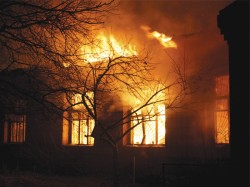The Law
Legal Spotlight

Insurer Wins Priest Abuse Case
Between 1979 and 1986, now-former priests of the Roman Catholic Church of the Diocese of Phoenix sexually abused adolescent males. The diocese settled four sexual abuse cases, and obtained partial coverage from its primary insurance carrier, Lloyd’s of London.
 Its excess liability carrier, Interstate Fire & Casualty Co., (IFC) denied the diocese’s claim. The insurer sought a declaration that it was not responsible for coverage, while the church sought $1.9 million in damages, claiming breach of contract and bad faith.
Its excess liability carrier, Interstate Fire & Casualty Co., (IFC) denied the diocese’s claim. The insurer sought a declaration that it was not responsible for coverage, while the church sought $1.9 million in damages, claiming breach of contract and bad faith.
The U.S. District Court for the District of Arizona found in favor of the church, but in a 2-1 decision, the U.S. 9th Circuit Court of Appeals reversed that decision in July.
The argument came down to whether “any” means “any” or whether it means “any one,” according to the majority opinion.
The insurance policy excluded liability “of any Assured for assault and battery committed by or at the direction of such Assured … .”
The appeals court agreed with IFC’s argument that “such Assured” refers back to “any Assured” — so that coverage would be excluded for “both the insured who committed the assault and battery as well as innocent co-insureds [referring to the diocese].”
It rejected the diocese’s “effort to infuse ambiguity into an otherwise clear agreement,” according to the opinion.
In a dissenting opinion, however, Senior Judge D.W. Nelson, found the wording more ambiguous, and said there were “three possible qualities that ‘such’ can refer to,” including Assureds facing liability; the “entire class of those covered by the policy;” or “those Assureds who committed or directed assault and battery.” Thus, she would have ruled in favor of the diocese.
The case was remanded to the lower court to determine attorneys’ fees and costs.
Scorecard: Interstate Fire & Casualty Co. was not responsible for more than $1.9 million in settlement costs.
Takeaway: The decision adds uncertainty to the so-called “any insured” exclusions, which generally are interpreted narrowly.
Warranty to Repair Supersedes an Implied Warranty
Doug and Karen Crownover spent “several hundred thousand dollars” to fix problems in the foundation and HVAC system at their Texas home, which was built by Arrow Development Inc.
In its October 2001 construction contract, Arrow had provided the Crownovers a warranty to repair work, but the developer failed to correct the problems or abide by an arbitrator’s ruling that ordered it to pay damages to the couple.
Arrow later entered bankruptcy, and the Crownovers sought recovery from Mid-Continent Casualty Co., which had issued a succession of comprehensive general liability policies to Arrow from August 2001 through 2008.
Mid-Continent denied the demand for payment, citing several exclusions in the policy. The couple then filed suit against the insurer for breach of contract, and a district court in Texas granted Mid-Continent’s request for summary judgment.
It based that decision — which was upheld by the U.S. 5th Circuit Court of Appeals in June — on a contractual-liability exclusion in the insurance policy.
That clause excludes claims when the insured assumes liability for damages in a contract or agreement unless the insured would be liable for those damages absent the contract. In this case, the contractual liability referred to the warranty to repair work that was included in the construction agreement.
The court rejected the couple’s argument that Arrow was liable for the repair work in the absence of the warranty because it had an “implied warranty of good workmanship.”
In its findings, the court ruled that the arbitrator found in favor of the Crownovers explicitly based on the warranty to repair, and that an express warranty supersedes an implied warranty. The court also ruled the arbitrator’s decision was based on Arrow’s failure to repair the work, not for the work done initially.
Scorecard: Mid-Continent Casualty Co. did not have to pay “several hundred thousand dollars” to the owners of a defectively built home.
Takeaway: The ruling aids insurers fighting indemnification in construction defect cases, as it narrows the scope of the contractual-liability exclusion that had been set in a recent Texas Supreme Court decision.
Effort to Focus on Condo’s Decreased Market Value Rejected
In 2010, a fire destroyed a commercial office condominium building owned by Whitehouse Condominium Group in Flint, Mich.
The Cincinnati Insurance Co. owed Whitehouse the “actual cash value” of that building at the time of loss. The question, eventually determined by the U.S. 6th Circuit Court of Appeals in June, was how much that actual cash value amounted to.
 Whitehouse said its claim amounted to $2.8 million. Cincinnati Insurance said the value was only $1.2 million because of a decrease in market value.
Whitehouse said its claim amounted to $2.8 million. Cincinnati Insurance said the value was only $1.2 million because of a decrease in market value.
The policy defined actual cash value as the “replacement cost less a deduction that reflects depreciation, age, condition and obsolescence.” At issue in the case was the definition of “obsolescence.”
While the insured argued the word related only to “functional” obsolescence — generally meaning something inherent to the building itself such as an outdated electrical panel — the insurance company said the word also included “economic” obsolescence, meaning a decrease in market value due to an external event.
Whitehouse said the insurer’s position was “definitional high jinks,” arguing that economic obsolescence is a “specialized concept used only in certain settings and does not fall within the general meaning of obsolescence.”
The U.S. District Court for the Eastern District of Michigan agreed with that position, ordering a summary judgment in favor of Whitehouse. On appeal to the 6th Circuit, a three-judge panel affirmed that decision.
Scorecard: The condominium association received $1.6 million more on its property claim due to the ruling.
Takeaway: When contract terms are ambiguous, the common definition applies, and in Michigan, in particular, if a term has two different reasonable interpretations, it is construed against the insurer.










